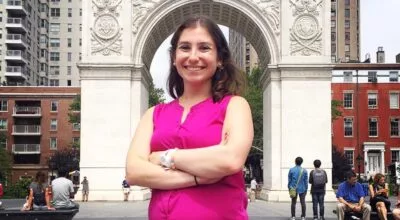The Power of Digital Storytelling: Reflections from the Springboard Fellowship

When I arrived on NYU’s campus as a Social Media Springboard Fellow, I imagined I would be creating content to post on each platform every day. But during those first few weeks, I learned that there was more to the job than I ever thought.
I spent much of my first year at the Bronfman Center trying to increase “likes” by making promotional graphics and videos about programs and events at the Bronfman Center. As I entered my second year, I began to work with my supervisor, Senior Brand Strategist Emily Hirsch, to create a more compelling and relevant strategy to reach the diverse groups of people that the Bronfman Center serves.
We set out to identify our core audiences with the goal of creating and maintaining long-lasting relationships with them using online tools. Referring to research on the effectiveness of storytelling as our basis, we decided to utilize the inspirational stories of our students and alumni through the format that is taking social media by storm, video, to convey that the Bronfman Center is changing lives.
Over the last year, we built a cohesive digital storytelling strategy with videos for Facebook and email newsletters at the core. And it’s one that any Hillel can adopt. To date, over 30 students and alumni have shared through these videos how the Bronfman Center has had a positive effect on them. Collectively, these videos have amassed more than 200,000 views.
To produce captivating story arcs about each interviewee’s Jewish journey, Emily and I worked together to develop a template of questions, such as “What were you looking for that drew you to the Bronfman community?” “What is your most memorable leadership experience at the Bronfman Center?” and “How has the Bronfman Center shaped your life?”
After interviewing and editing the footage, we posted individual 60-second long videos on our Facebook page and targeted newsletters for parents, alumni and students. We believed that many of our students saw the Bronfman Center as a caring and supportive community within the overwhelming environment of New York City, and these videos confirmed our belief.
Carly Stern, a rising NYU senior, shared in her video that she was initially very nervous to go on Birthright Israel. When her group visited the Western Wall, she couldn’t figure out how she felt. She realized then that the community she was traveling with in Israel was going to be an essential part of her Jewish self-discovery in college. Since then, she has grown the Birthright Israel community at NYU as a Birthright Israel Fellow under the advisement of our IACT Coordinator for Israel Engagement, Omer Hit.
Let me introduce you to a few of those students.
Recent graduate James Beck found that joining a Jewish community in college was challenging because his classes were on NYU’s Brooklyn campus. In his video, James, a Bronfman Center engagement intern, described hosting an event in Brooklyn with our JLIC Rabbi Joe Wolfson. Through relating to other students who also felt disconnected from campus Jewish life, he learned how impactful it can be to feel part of the Bronfman community.
Martine Duffy, a rising NYU sophomore described in her video that she was worried about missing her family’s Jewish traditions when she got to college. She wasn’t sure at first if she wanted to attend rehearsals for Shabband, the student band that leads Reform services, because she thought people wouldn’t like her. But she tried it one week, and over time she found her spiritual community through playing guitar every Friday night with her peers.
Now, Martine feels like she is accepted and welcomed at Shabbat services, and everything she does, at the Bronfman Center.
Sentiments about Hillel are hard to measure, but our students’ qualitative testimonials speak for themselves. We should share this “Hillel effect” that our global movement is having on the future of the Jewish people. Through utilizing digital storytelling, we can enrich the lives of more students than we ever have before.
Each of these stories represents a different lived experience of Hillel. Individually and collectively, they help build our brand.
Today’s digital landscape offers campus Hillels the ability to build relationships with audiences online. We at the Bronfman Center still have a lot to learn about these digital tools, and we know that. Our next challenge is figuring out how to track these impact stories in a data-driven way to determine which stories are driving philanthropic support to our Hillel.
But one thing is clear: We must continue to harness the power of social media and share our story widely. Social media may be a new phenomenon, but storytelling is not. Telling stories is as old as humankind, and this ancient tradition may just be the best way to ensure the future of our vital mission.